NG availability
"Recognizing the abundant supply of natural gas in the United States and Canada, we feel compelled to invest in our products in such a way that enables our customers to expand their usage of very low emissions technologies through our engines," said Jim Hebe, senior vice president, North American sales operations, Navistar. "The use of natural gas certainly accomplishes this and we are proud to be developing the broadest, most energy-efficient line of trucks in the industry, helping deliver real-world savings to the bottom line."
Hebe went on to say, “As we assess changing market conditions, the ability to offer customers choices is important not only in our U.S. markets, but in our global markets, as well. As we develop this product for our International truck customers, we will also be able to leverage the technology in other markets and products as appropriate.”
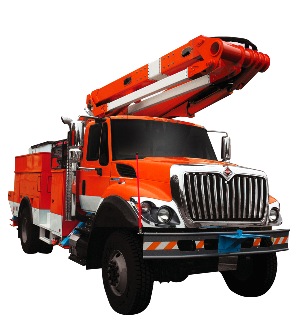
Navistar, in partnership with Clean Air Power Ltd., has built and tested a 2011 International ProStar+ 122-in. BBC tractor with a 430 HP, 1,550 ft./lb. dual fuel MaxxForce 13-liter engine. This vehicle is currently in the development phase. The engine uses diesel pilot injection for combustion on the compression stroke and mixes air and LNG on the intake stroke. The result is an engine that runs on a mixture of 15% diesel and 85% natural gas.
The dual fuel 13-liter MaxxForce engine includes minimal changes to the stock diesel engine other than the addition of a natural gas injection system. Beyond the LNG ProStar+, Navistar has initiated a number of alternative fuel vehicles over the past several years, Hebe said. The company introduced diesel-electric hybrid versions of its International DuraStar and International WorkStar trucks as well as diesel-electric hybrid and plug-in hybrid versions of its IC Bus brand school and commercial buses. Navistar has also recently demonstrated compressed natural gas (CNG) versions of its DuraStar and WorkStar trucks. Hebe noted that Navistar has broad lineups of alternative fueled vehicles, including an all-electric eStar truck, which the company introduced most recently.
Who’s buying?
Robert Carrick, vocational sales manager, natural gas, Daimler Trucks North America (DTNA) said that there are many types of fleets buying NG-powered trucks—not just the traditional buyers like municipalities—by purchasing small numbers of vehicles to try them out. “These are primarily regional fleets, including waste haulers,” he noted, “that travel about 250 miles per day and return to a home terminal for refueling.” He added that Ryder is also actively purchasing these vehicles to lease and they are offering to supply NG to lessees, which is a significant incentive given the fact that NG can be difficult to access for fleets that do not have an infrastructure of their own.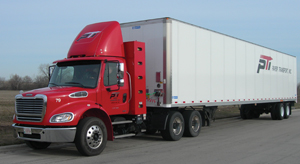
David Bryant, manger of vocational sales for DTNA, stated that the appeal of diesel-electric hybrid trucks might be greater for some applications because hybrids do not require the infrastructure needed by NG trucks. “Some of the sectors that are most interested are the food and beverage industry and package delivery fleets.” While the American Recovery and Reinvestment Act (ARRA) of 2009 funding has gone away, other financial incentives are available to offset the purchase price, he noted. Some of the funding is available from the Clean Cities Coalition, particularly in the areas of non-attainment. “California is offering significant financial incentives for fleets to purchase hybrid vehicles,” Bryant noted. “The California Air Resources Board (CARB) hybrid voucher project provides $15,000 to $30,000 off the purchase price of hybrid vehicles depending on the GVW.”
Hybrid trucks make a lot of sense for fleets that use stationary PTOs (construction and utility trucks as well as municipality fleets fall into this category). “Hybrids in these applications can save as much as 40% to 50% on fuel in PTO mode and typically 20% to 30% in driving mode,” added Bryant.
Bryant and Carrick noted that hydraulic-assist hybrids fit a specific niche in the refuse hauling market, but they said in many cases NG-powered vehicles may be the better choice for this application considering the fact that NG–powered engines have a simpler three-way catalyst exhaust system and NG is a less expensive fuel. Also, greenhouse gas emissions are at least 25% lower than diesel, and reclaimed landfill gas is a much higher emission reduction than that number. They noted that some waste haulers are already calculating and recording their GHG credits for future use.
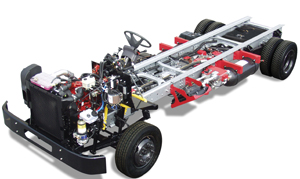
DTNA is actively involved in a number of projects to improve fuel economy and reduce greenhouse gas emissions. These include: DOE SuperTruck Program—research project to demonstrate 50% improvement in ton-mile per gallon freight efficiency; Project 20/20—Daimler initiative to improve fuel economy 20% by 2020; and NHTSA/EPA fuel economy standards—meet and exceed upcoming fuel economy standards through improvements in powertrain, aerodynamics, weight reduction and other commercially viable technologies.
Bryant suggested that hybridization would likely continue as an option, as well expansion of NG engine offerings meeting the needs of both heavier and lighter vehicle configurations. In addition, we can expect to see more onboard technologies like the DTNA SmartCruise, which is adaptive cruise control utilizing 3D mapping intelligence to optimize throttle control and subsequently increase fuel efficiency. To further optimize engine performance, Bryant said, “We have several work streams in place to continue refining our engine, powertrain and vehicle aerodynamics to maintain our industry-leading position on fuel efficiency. To date, engine and truck manufacturers have done a phenomenal job reducing criteria pollutants, NOx and particulates—the U.S. has the lowest emission-emitting engines in the world. DTNA will continue its commitment to improve fuel economy and lower emissions. Not just to meet future mandates (2014 and beyond), but to provide best in class operational costs for our customers.”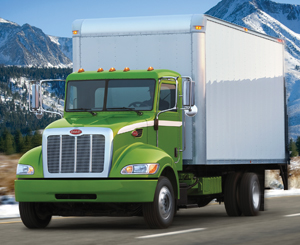
Lower emission benefits
Peterbilt’s market segment manager Steve Weiner stated, “Our Class 8 over the road, regional haul, vocational users, refuse operators and port operations are all purchasing alternative fuel vehicles to take advantage of the lower operating costs, the lower emissions benefits and the use of domestically-sourced fuel they offer.” One of the best incentives for these purchases is the current national 50-cent per gallon Alternative Fuel Excise Tax Credit on the purchase of natural gas. Fleets also have the option of state and local incentive programs.
In addition to federal government incentives for purchasing alternative fuel vehicles, efforts are being made to strengthen the infrastructure across the nation. As the market leader in alternative fuel trucks with eight model options, Peterbilt hosted Texas Governor Rick Perry at its Denton manufacturing facility for a special bill signing ceremony supporting the development of natural gas initiatives in Texas. Senate Bill 20 establishes a natural gas transportation corridor in the rapidly expanding Texas Triangle, which encompasses Austin, Dallas/Fort Worth, Houston and San Antonio, by increasing the number of natural gas refueling stations, supporting the use of natural gas-powered trucks.
NG vehicles aren’t the only alternative fuel option available. “Hybrid technology offers optimized savings for applications that feature increased idle time or stop-and-go driving. This is particularly true for municipalities, utilities, and urban pickup and delivery applications.” Weiner noted. “Hybrid technology is focused on developing increased energy storage to enhance fuel economy and performance, and ongoing research and testing is being conducted to improve performance and reliability in these environmentally-sound solutions.”
According to Andy Douglas, national sales manager for specialty markets at Kenworth, when it comes to the purchasing of alternative fuel vehicles, “the true early adopters were municipalities—and their interest continues, particularly in natural gas. Now we are seeing similar leadership in the on-road segment from food, beverage and dairy fleets. We are starting to see increased interest from oil and gas service companies that are buying these trucks, as well.”
Douglas notes that Kenworth, which has been working with its existing hybrid system since 2007, continues to evolve the technology. “We added a single axle tractor to the model line two years ago, which is the most popular application to-date. The strengths of this hybrid truck are in its ability to perform well in urban stop-and-go conditions. As we plan for the future, we are working on technology that adds longer distance capabilities to the hybrids, as well as adding heavier load capabilities.”
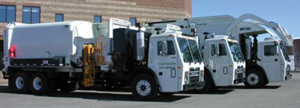
He also suggests that, as the interest in alternatively-powered vehicles continues, those that will have the most success are those that build on traditional technology. “With natural gas and plug-in electric options, there is already infrastructure in place,” he said. “The same is true of diesel-electric hybrids, which allow for a big bang for the buck when it comes to the potential for of 30% to 40% fuel economy improvements.”
NG for refuse hauling
Curtis Dorwart, Mack Trucks Inc.’s vocational marketing product manager, said, “Mack has been involved in NG since the early 1990s and currently offers natural NG-powered versions of the best-selling refuse trucks in the industry, the Mack TerraPro Cabover and TerraPro Low Entry. Many municipalities and private refuse companies are on board with natural gas because their trucks return home every night (availability/infrastructure is not an issue), natural gas is currently priced quite lower than diesel, and some states, particularly those with more abundant supplies of natural gas, still offer tax incentives.”
Dorwart added, “We see the greatest long-term potential in the conversion of biogas—available at a landfill, for example—to clean renewable methane for use as transportation fuel. Like natural gas, hybrid technology has the greatest potential in refuse and urban pickup and delivery applications, but for a different reason—the stop-and-go nature of these applications.”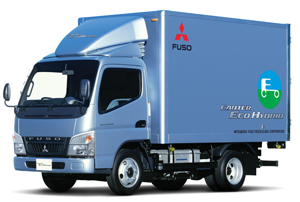
NG for daycabs
Ed Saxman, Volvo Trucks product manager, powertrain, said, “Volvo Trucks offers a natural gas option for its VNM daycab. These vehicles are ideal for port drayage, pickup and delivery applications, grocery and beverage haulers, or private fleets—essentially any fleet that can return to a central fueling station.”
Saxman agrees with Dorwart, “Natural gas-powered trucks are most prominent in the refuse segment because the trucks return each day to a central refueling location. The lack of broader, public natural gas infrastructure limits the ability to use natural gas-powered trucks in long-haul applications. Currently there are no federal natural gas incentives, however, some states continue offering tax incentives for installing natural gas fueling stations or purchasing natural gas-powered trucks.”
Hybrid systems
Eaton said its electric hybrid power system uses a parallel configuration that maintains the vehicle’s conventional drivetrain layout and uses patented controls to blend engine torque with electric torque to move the vehicle. The system recovers power normally lost during braking and stores the energy in batteries and can provide engine-off power take off and work site capability for those needing hydraulic operations and an auxiliary electric power source from the vehicle. As an additional benefit, should the hybrid electric system go off-line, conventional engine-powered operation continues.
The company added that it coupled the vehicle’s engine with its UltraShift automated manual transmission and clutch. Between the output side of the clutch and the transmission, it integrated an electric motor/generator that is connected to a power inverter and lithium ion batteries and controlled with its electronic control module. The company also offers a hydraulic assist system, HLA hydraulic hybrid system, which has two main parts: regeneration and acceleration.
During regeneration, the vehicle’s kinetic energy that is normally lost during braking is captured and used to drive the pump/motor as a pump. The pump action transfers hydraulic fluid from a low-pressure reservoir to a high-pressure accumulator. As the fluid pumps into the accumulator, it compresses nitrogen gas and pressurizes the system. The regenerative braking captures about 70% of the kinetic energy produced during braking.
Increased awareness of hybrids
“There has been a significant increase in awareness of new hybrid systems for medium- and heavy-duty (Class 3-8) in several different markets,” says Brad Hicks, executive engineer of government technical affairs for Meritor. “Most of the systems are mild parallel systems where the engine and wheels always connect with a motor and battery to store electricity.” A lot of medium-duty hybrid truck applications that use this store-and-go technology have the added benefit of harnessing the auxiliary power to run PTOs for added equipment like utility operations that power external buckets, etc.”
Tammy Packard, Meritor’s product manager—hybrids, notes that one of the best applications of hydraulic hybrids is in the waste-hauling sector. “For example,” she says, “If you have energy storage, then you only have to consider what you can do with it—when idling the truck, how you can harness the energy to reduce emissions or provide power for key-off hotel loads that provide driver comfort, which can be done with the available power rather than using a onboard generator or plug-in.”
“Meritor,” says Hicks, “has been focusing on dual-mode hybrid technology, which operates as a series hybrid and parallel systems with a combustion engine assist. This system provides power to the tractor at low speeds and at speeds of 40 to 50 MPH it goes into parallel mode.” This system can be used instead of an engine brake to slow trucks and the energy that is captured during braking is stored in the batteries for later.
“In addition,” notes Packard, “fleets can gain fuel efficiency and lower emissions, which is a big concern.” Incentives were available for certain fleets in some applications, but those went away at the end of 2009.
“Acquisition cost is a big issue,” Hicks adds. “R&D funding allows companies that develop these technologies to have a full-court press in designing ways to drive out costs and create more ways to save fuel. I’m not suggesting that those of us developing these systems want charity, we would just like funding to help us jump-start programs that encourage fleets to purchase trucks with new technology. Once sales start to increase, the costs will automatically be driven down by volume buying.”
Packard believes that fleets are poised for greater acceptance of the new technology. Citing a recent user survey, she says, “We asked fleets if they were ‘for’ or ‘against’ EPA and NHTSA regulations that are aimed at reducing greenhouse gases. And we were surprised to find that 90% of those surveyed not only recognized the importance of providing technology that creates more fuel-efficient vehicles, but they also stated that there needed to be a basic understanding of the technology in this country and that they believed that advancement in this technology and the production of more advanced vehicles could be a way to create jobs in the U.S.”
Hybrids as viable investments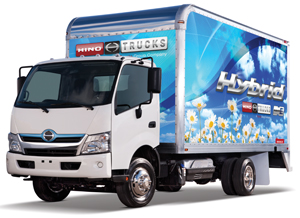
Todd Bloom, president and CEO of Mitsubishi Fuso Truck of America Inc., said that right now those individuals or fleets who are purchasing hybrid trucks are essentially making a statement—which suggests that hybrids are still in the “concept” stage rather than being commercially viable.
“If we look at the typical medium-duty fleet buyers, which Mitsubishi Fuso buyers are,” Bloom stated, “the average truck logs about 28,000 miles per year. The payback for the cost of a hybrid versus the cost of a diesel-powered truck—based on $4.00 to $4.25 per gallon for diesel—is between $7,000 and $8,000, which is realized in about four to five years.” This suggests that to be a commercially viable investment, the upfront cost of hybrid trucks needs to be lower.
While there are still some government incentives available for certain fleets purchasing hybrids, Bloom noted that truck OEMs couldn’t rely on the impetus from these incentives to build a product development plan. Truck makers simply are not going to develop business models based on the hope of government subsidies. Rather, they are going to refine their hybrid technology to drive down costs and improve vehicle performance. To that end, Bloom noted that right now Mitsubishi Fuso Truck and Bus Corp. in Tokyo, Japan, has over 100 engineers dedicated to further development of hybrid technology.
“The key to commercial viability comes from technical improvements,” added Bloom. “For instance, performance efficiencies may be gained through Hybrid design decisions and systems. Our engineers are currently working on refining our diesel-electric hybrid Canter with the Fuso 4P10 engine. This includes further vehicle weight reductions, new battery technologies and other performance enhancement components.”
Bloom said that the company is working to realizing its hybrid goals, and hinted that the introduction of new products might be in the not-too-distant future.
Creating economic value for hybrids
According to Glenn Ellis, vice president of marketing and dealer operations for Hino Trucks, “Today many private fleets will not consider hybrids because there is not a hybrid solution in the market that offers an economic payback within 5 years or less even after applied government/state incentives, so the typical first owner never recovers their investment. I’m very proud to say that our Hino Hybrid will be the first hybrid solution to break this barrier and create economic value for fleets, in addition to being the right choice for the environment. As you heard at our product launch event, our hybrid in the right applications will have a payback within 5 years prior to consideration of any government/state incentives.”
So who is buying? Municipalities and national fleets that feel a social responsibility and take advantage of the “green” image the trucks provide, according to Ellis. Also buying are fleets operating in cities/states with regulating product specifications (i.e., Long Beach, Calif., where it is required as a cost of doing business). In addition, fleets operating in areas in which the infrastructure for a particular alternative fuel type is supported and readily available are purchasing hybrids, as well as smaller fleets when it makes sense for the image of the company.
Ellis went on to say, “It is very difficult to keep track of all of the state incentives, but many of the states are still offering tax incentives to purchase hybrid vehicles. The state of California is still a big supporter of hybrid purchases through the Hybrid Vehicle Incentive Program (HVIP). With this program, in 2011 a fleet can receive up to a $15,000 rebate for purchasing a medium-duty hybrid vehicle. This program is funded through new vehicle registrations, so the amount per vehicle varies from year to year. There will be a program in 2012, but the amounts have not been approved. It is still uncertain to whether or not the program will exist beyond 2012.”
As for future hybrid technology, “The fleets are asking the OEMs to develop integrated hybrid powertrain vehicles similar to what we are releasing later this year,” Ellis stated. “By doing this, the industry can bring down the cost of hybrid systems, which will lend this technology to more applications. We believe our hybrid truck will do very well in all metropolitan delivery applications (document/office supply, beverage, food distribution, general freight, etc). Another application that would benefit greatly from hybrid trucks is utility trucks. These trucks sit idle on the side of the road for the majority of their duty cycle but have to run to keep the buckets operational. The ideal situation is for the buckets to run off of the stored battery power, however, the battery technology is not there yet to support this concept.”
The performance of hybrid solutions definitely excels in intra-city operation environments characterized by heavy stop/start activity and lower operating speeds. Ellis noted, “In our internal testing, trucks that operate on average between 12-19 MPH will benefit the most from hybrid technology. This average includes normal idle time and stop-
and-go-patterns. We have seen as much as a 30% improvement in fuel economy compared to an EPA 07 truck operating in this range.”
What does the future hold? All types of technology are being introduced into the commercial truck market, including alternative fuels, electric vehicles, hybrid trucks and more. Ellis noted that from a truck performance standpoint, diesel electric-hybrid trucks still offer the best overall solution in providing fuel economy, durability, CO2 emissions and low cost of ownership. Pure electric vehicles are very costly, have limited range and have a reduced payload due to the added weight of the batteries. Alternative fuels do not have the infrastructure nationally. As Toyota continues to develop its hydrogen fuel cell technology, it may be a logical next step to try and carry that technology over to light- and medium-duty trucks.


